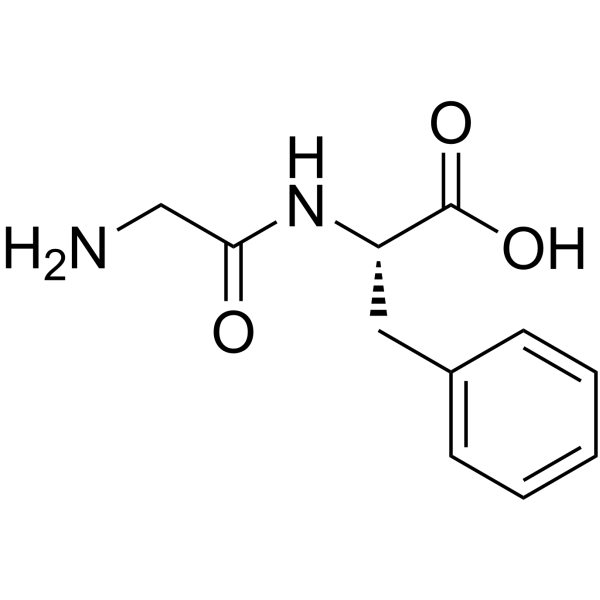H-Gly-Phe-OH

H-Gly-Phe-OH structure
|
Common Name | H-Gly-Phe-OH | ||
|---|---|---|---|---|
| CAS Number | 3321-03-7 | Molecular Weight | 222.24000 | |
| Density | 1.259g/cm3 | Boiling Point | 492.2ºC at 760mmHg | |
| Molecular Formula | C11H14N2O3 | Melting Point | ~264 °C (dec.) | |
| MSDS | Chinese USA | Flash Point | 251.5ºC | |
|
Transport and signaling via the amino acid binding site of the yeast Gap1 amino acid transceptor.
Nat. Chem. Biol. 5 , 45-52, (2009) Transporter-related nutrient sensors, called transceptors, mediate nutrient activation of signaling pathways through the plasma membrane. The mechanism of action of transporting and nontransporting transceptors is unknown. We have screened 319 amino acid anal... |
|
|
Equivalent Isopropanol Concentrations of Aromatic Amino Acids Interactions with Lipid Vesicles.
J. Membr. Biol. 248 , 695-703, (2015) We show that the interaction of aromatic amino acids with lipid bilayers can be characterized by conventional 1D [Formula: see text]H NMR spectroscopy using reference spectra obtained in isopropanol-d8/D[Formula: see text]O solutions. We demonstrate the utili... |
|
|
Cytochrome P450 inhibition potential of new psychoactive substances of the tryptamine class.
Toxicol. Lett. 241 , 82-94, (2015) New psychoactive substances (NPS) are not tested for their cytochrome P450 (CYP) inhibition potential before consumption. Therefore, this potential was explored for tryptamine-derived NPS (TDNPS) including alpha-methyl tryptamines (AMTs), dimethyl tryptamines... |
|
|
Quantitative detection of caffeine in human skin by confocal Raman spectroscopy--A systematic in vitro validation study.
Eur. J. Pharm. Biopharm. 95 , 110-6, (2015) For rational development and evaluation of dermal drug delivery, the knowledge of rate and extent of substance penetration into the human skin is essential. However, current analytical procedures are destructive, labor intense and lack a defined spatial resol... |
|
|
Nitazoxanide, an antiviral thiazolide, depletes ATP-sensitive intracellular Ca(2+) stores.
Virology 462-463 , 135-48, (2014) Nitazoxanide (NTZ) inhibits influenza, Japanese encephalitis, hepatitis B and hepatitis C virus replication but effects on the replication of other members of the Flaviviridae family has yet to be defined. The pestivirus bovine viral diarrhoea virus (BVDV) is... |
|
|
Generation of amphidiploids from hybrids of wheat and related species from the genera Aegilops, Secale, Thinopyrum, and Triticum as a source of genetic variation for wheat improvement.
Genome 58 , 71-9, (2015) We aim to improve diversity of domesticated wheat by transferring genetic variation for important target traits from related wild and cultivated grass species. The present study describes the development of F1 hybrids between wheat and related species from th... |
|
|
Riboflavin-binding protein is a novel bitter inhibitor.
Chem. Senses 33(1) , 57-63, (2008) Riboflavin-binding protein (RBP) from chicken egg, which was recently reported to be a selective sweet inhibitor for protein sweeteners, was also found to be a bitter inhibitor. RBP elicited broadly tuned inhibition of various bitter substances including quin... |
|
|
Human PEPT1 pharmacophore distinguishes between dipeptide transport and binding.
J. Med. Chem. 49 , 3636-44, (2006) The human intestinal oligopeptide transporter (PEPT1) facilitates the absorption of dipeptides, tripeptides, and many peptidomimetic drugs. In this study, a large number of peptides were selected to investigate the structural features required for PEPT1 trans... |
|
|
Molecular mechanism of the inhibition of cytochrome c aggregation by Phe-Gly.
Arch. Biochem. Biophys. 435(1) , 182-9, (2005) Experimental and computational studies suggest that few general principles govern protein/protein interactions and aggregation. The knowledge of these rules may be exploited to design peptides that are able to interfere with the self-assembly and aggregation ... |
|
|
Intrinsic folding of small peptide chains: spectroscopic evidence for the formation of beta-turns in the gas phase.
J. Am. Chem. Soc. 127(2) , 707-12, (2005) Laser desorption of model peptides coupled to laser spectroscopic techniques enables the gas-phase observation of genuine secondary structures of biology. Spectroscopic evidence for the formation of beta-turns in gas-phase peptide chains containing glycine an... |